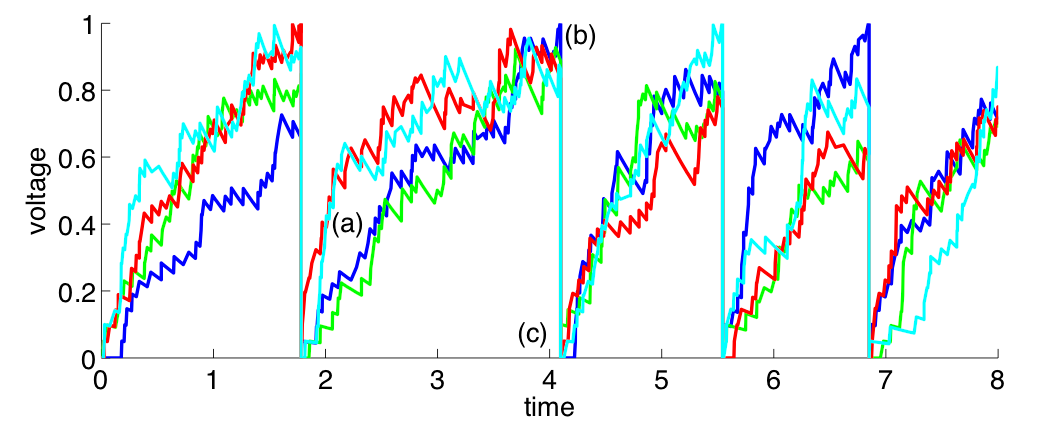
Introduction
This project concerns developing theoretical models of processing taking place in a number of brain areas, mostly early sensory pathways. One set of problems we have addressed concerns the asynchronous steady state of a sparsely, randomly connected neuronal network. Another set of problems addresses collective oscillations in neuronal networks, including periodic total firing events in all-excitatory networks, the role of network oscillations and their extinction driven by fast excitatory and fast and slow inhibitory currents in early insects olfactory processing, and the role of direct resistive connections between neurons, known as gap junctions, in facilitating neuronal network oscillations. Another set of problems concerns the role of compressive sensing in early sensory input processing. Yet another concerns the role of network topology in the nature of its firing patterns. We use minimal models that capture plausible mechanisms underlying the specific dynamical behavior exhibited by networks of neurons, and help formulate plausible physiological hypotheses. These models range from full conductance (Hodking-Huxley) type, through integrate-and-fire, kinetic theory and Fokker-Planck equations, to firing-rate, and we study them both computationally and also analytically.
Affiliated Researchers
Internal Collaborators:
- Peter Kramer
Current Graduate Research Assistants:
- Paulina Volosov
- Devin Smith
Past Graduate Research Assistants:
- Katie Newhall (now at UNC Chapel Hill)
- Victor Barranca (now at Swarthmore College)
- Pamela Pyzza (now at Ohio Wesleyan University)
- Jennifer Crodelle (now at Courant Institute)
Past Postdoctoral Research Fellows:
- Maxim Shkarayev (now in industry)
External Collaborators:
- David Cai (deceased)
- Douglas Zhou (Shanghai Jiaotong University)
- Aaditya Rangan (Courant Institute)
- Louis Tao (Peking University)
Resources
Selected Publications:
Q. L. Gu, Z. K. Tian, G. Kovacic, D. Zhou, and D. Cai [2018]. The Dynamics of Balanced Spiking Neuronal Networks Under Poisson Drive Is Not Chaotic, Frontiers in Computational Neuroscience 12, 47.
V. J. Barranca, G. Kovacic, D. Zhou, and D. Cai [2016]. Improved Compressive Sensing of Natural Scenes Using Localized Random Sampling, Nature Scientific Reports 6, 31976.
V. J. Barranca, G. Kovacic, D. Zhou, and D. Cai [2016]. Efficient Image Processing Via Compressive Sensing of Integrate-And-Fire Neuronal Network Dynamics, Neurocomputing 171, 1313-1322.
K. A. Newhall, M. S. Shkarayev, P. R. Kramer, G. Kovacic, and D. Cai [2015]. Synchrony in Stochastically Driven Neuronal Networks with Complex Topologies, Phys. Rev. E 91, 052806.
V. J. Barranca, G. Kovacic, D. Zhou, and D. Cai [2014]. Network Dynamics for Optimal Compressive Sensing Input Signal Recovery, Phys. Rev. E 90, 042908.
V. J. Barranca, G. Kovacic, D. Zhou, and D. Cai [2014]. Sparsity and Compressed Coding in Sensory Systems, PLOS Comput. Biol. 10(8), e1003793.
V. J. Barranca, D. C. Johnson, J. L. Moyher, J. P. Sauppe, M. S. Shkarayev, G. Kovacic, and D. Cai [2014]. Dynamics of the Exponential Integrate-and-Fire Model with Slow Currents and Adaptation, J. Comput. Neurosci. 37(1), 161-180.